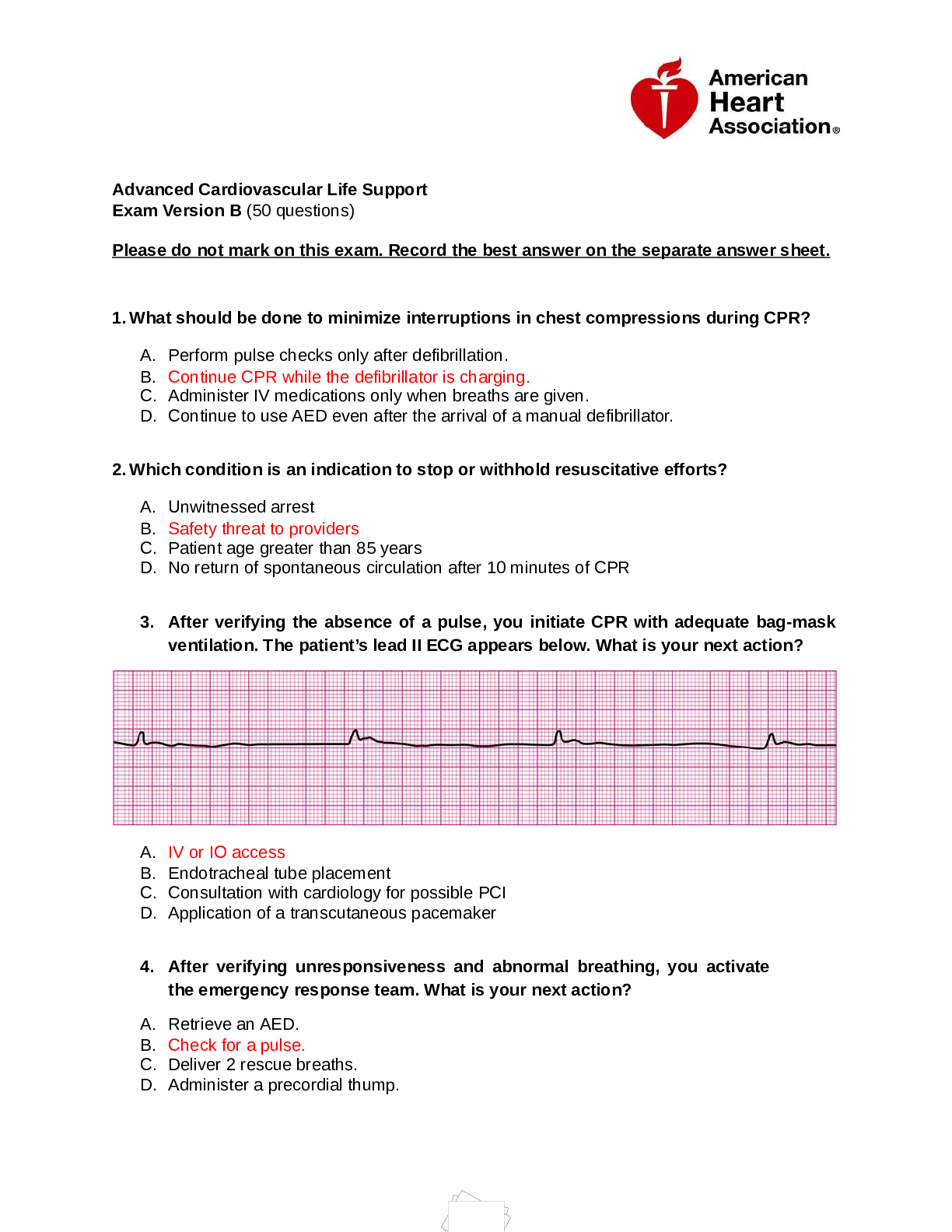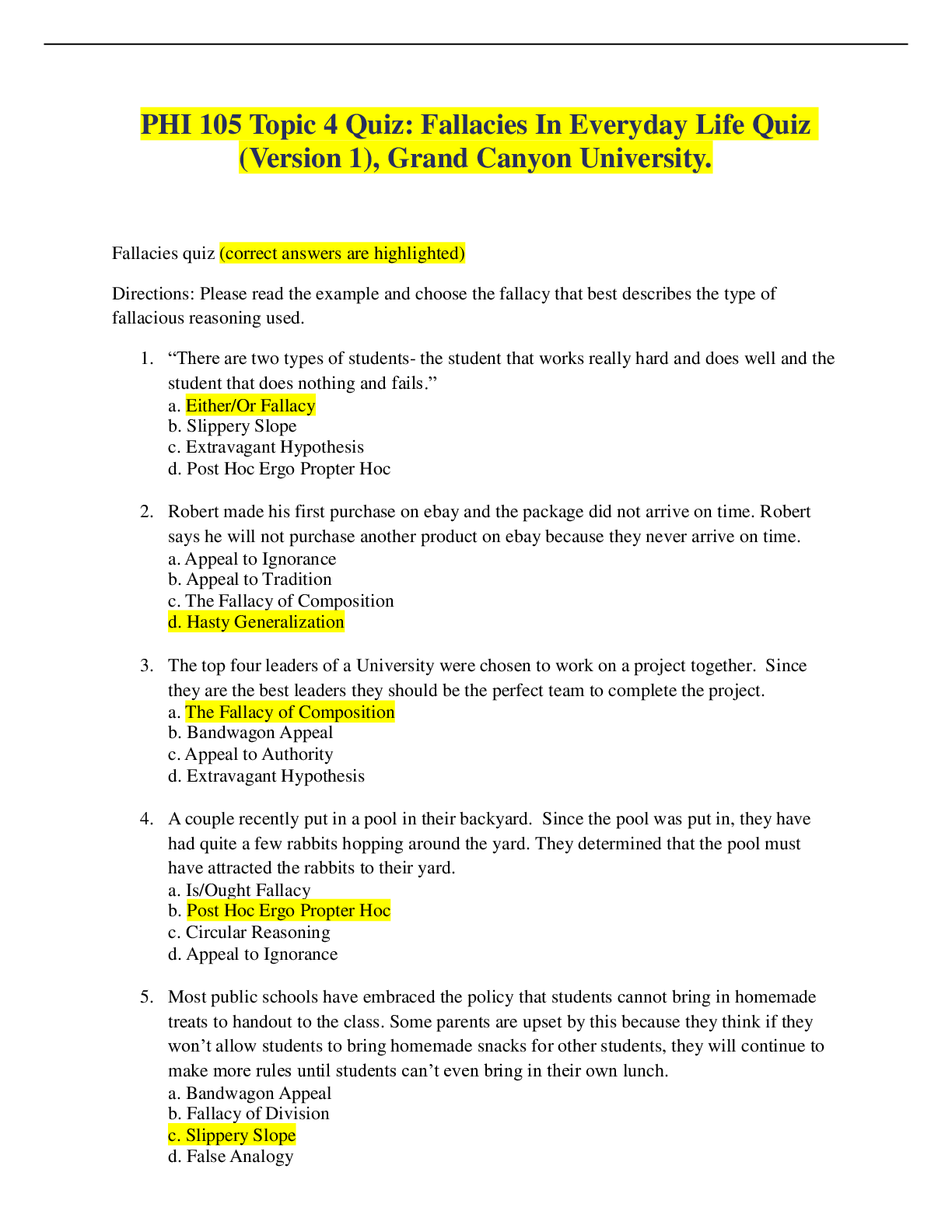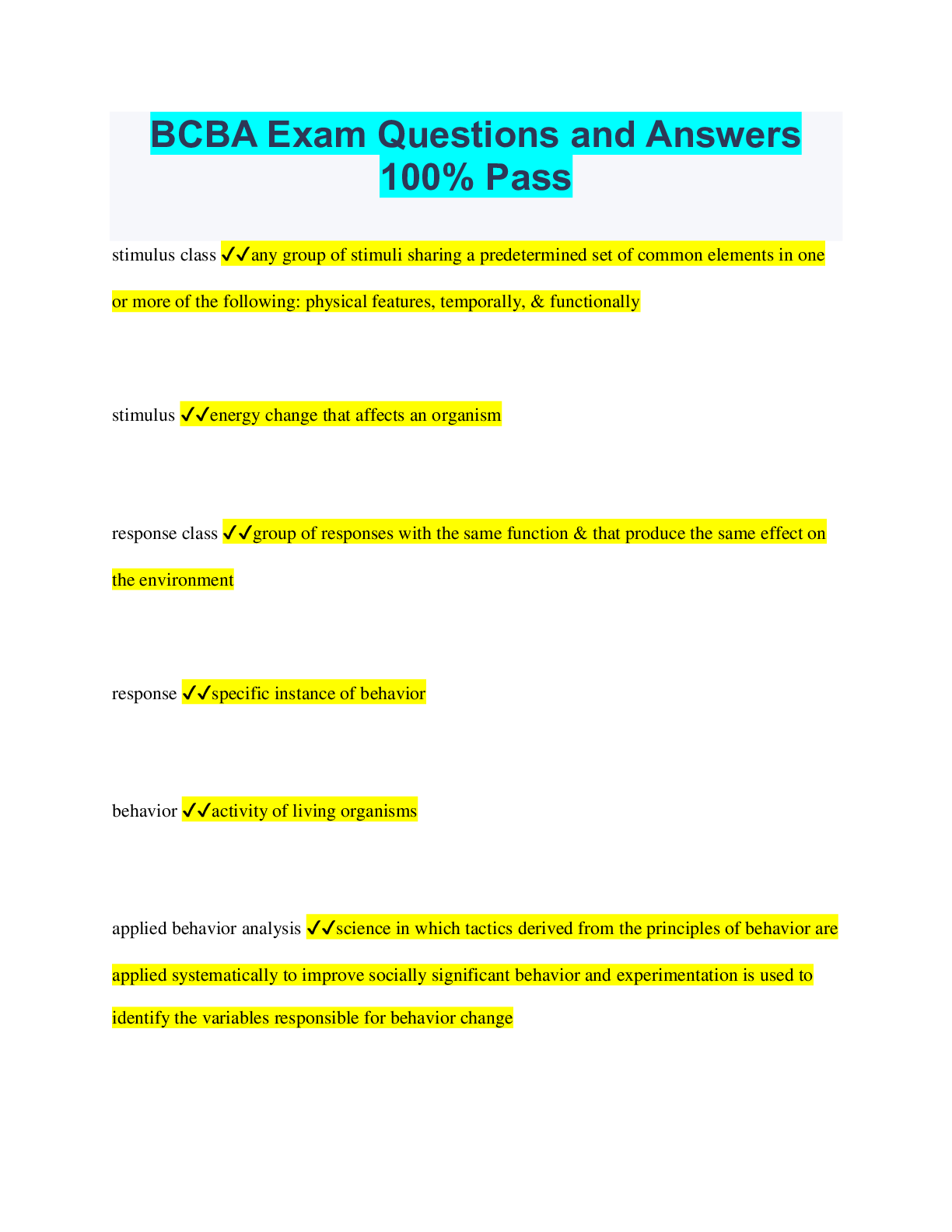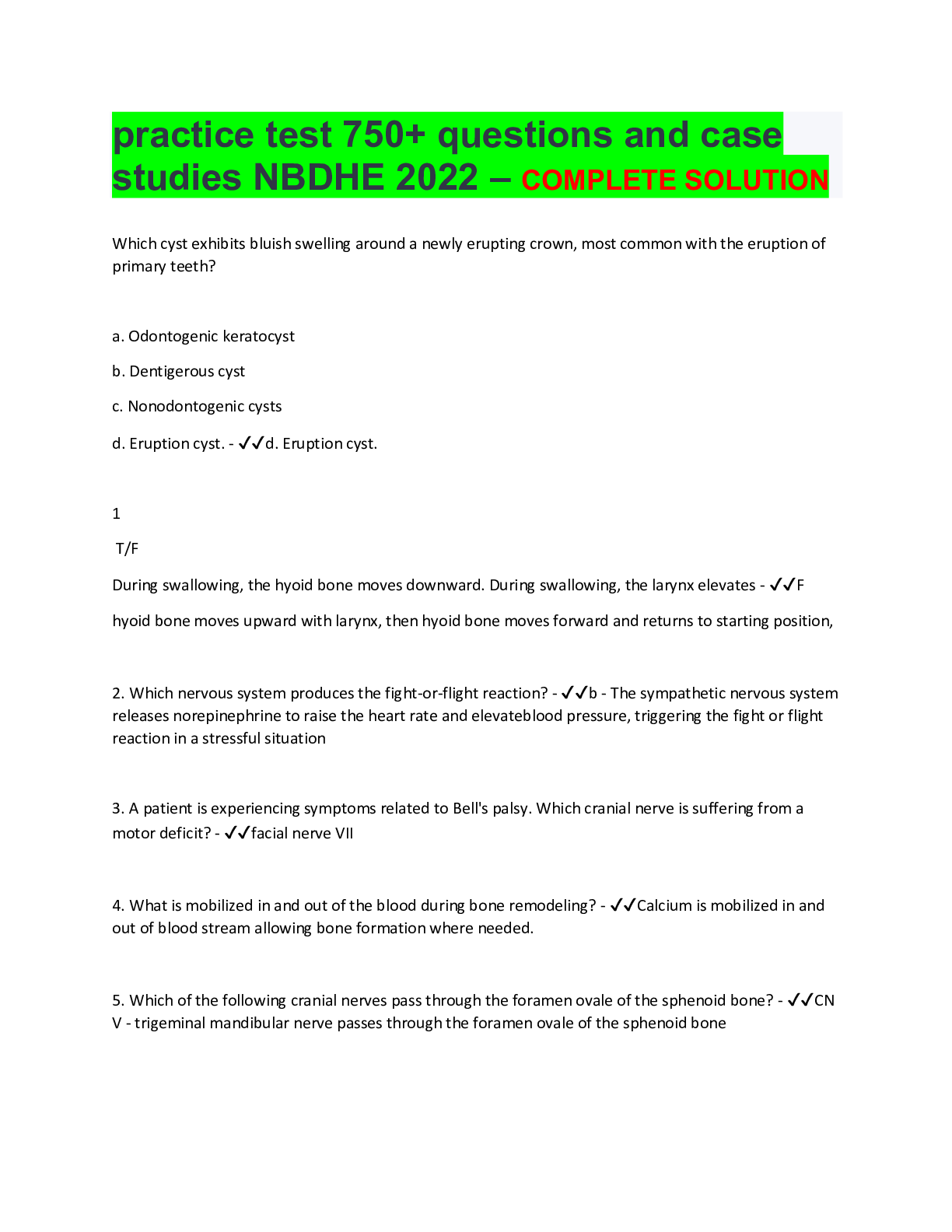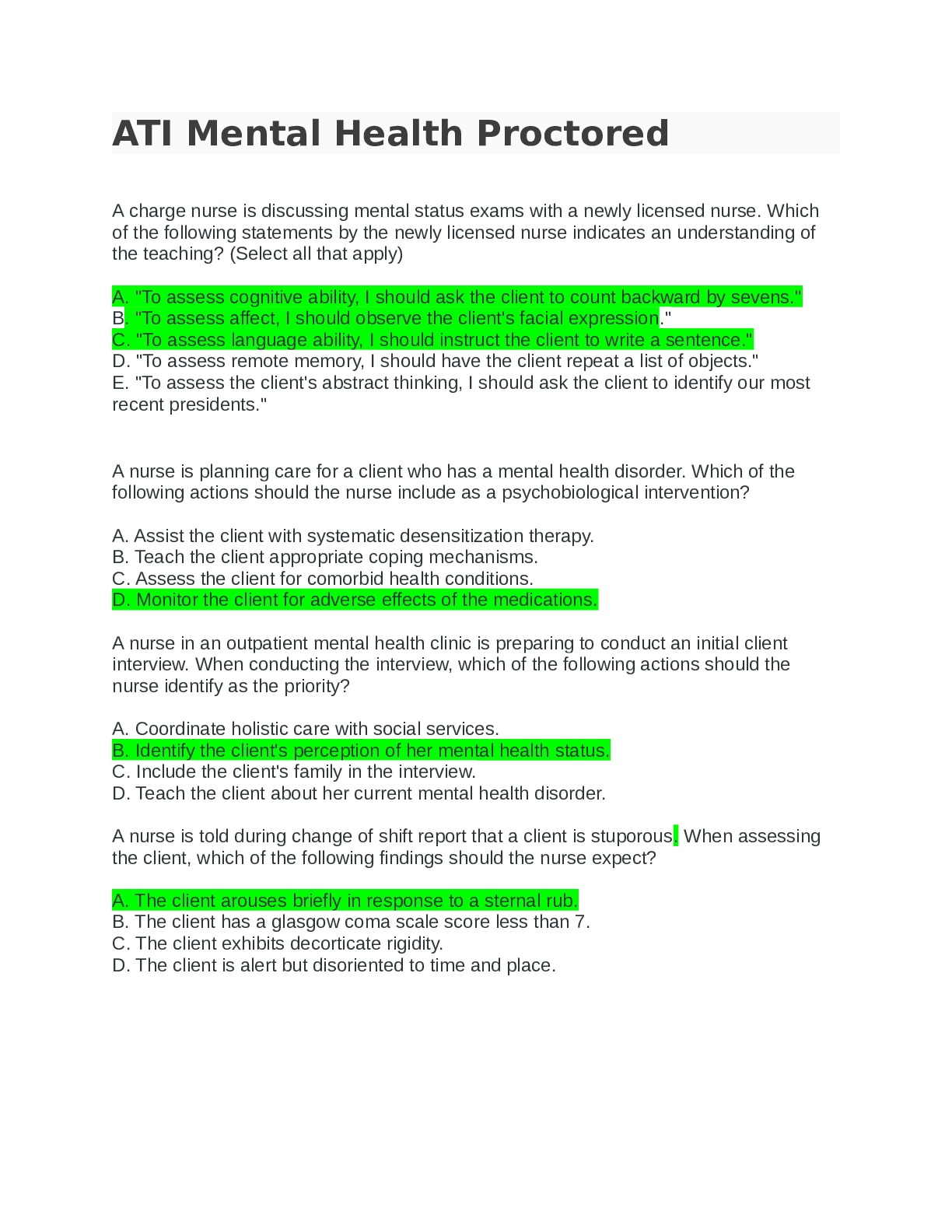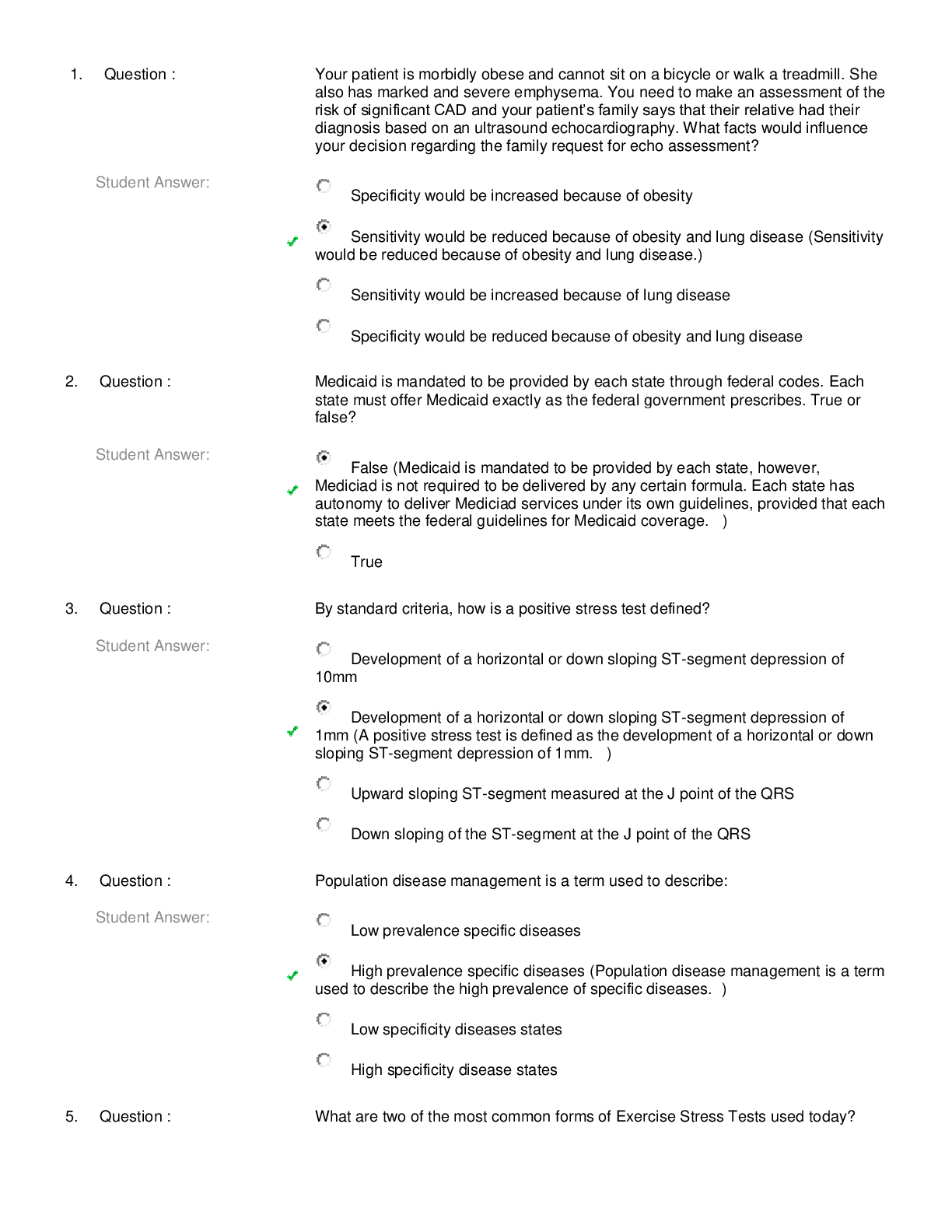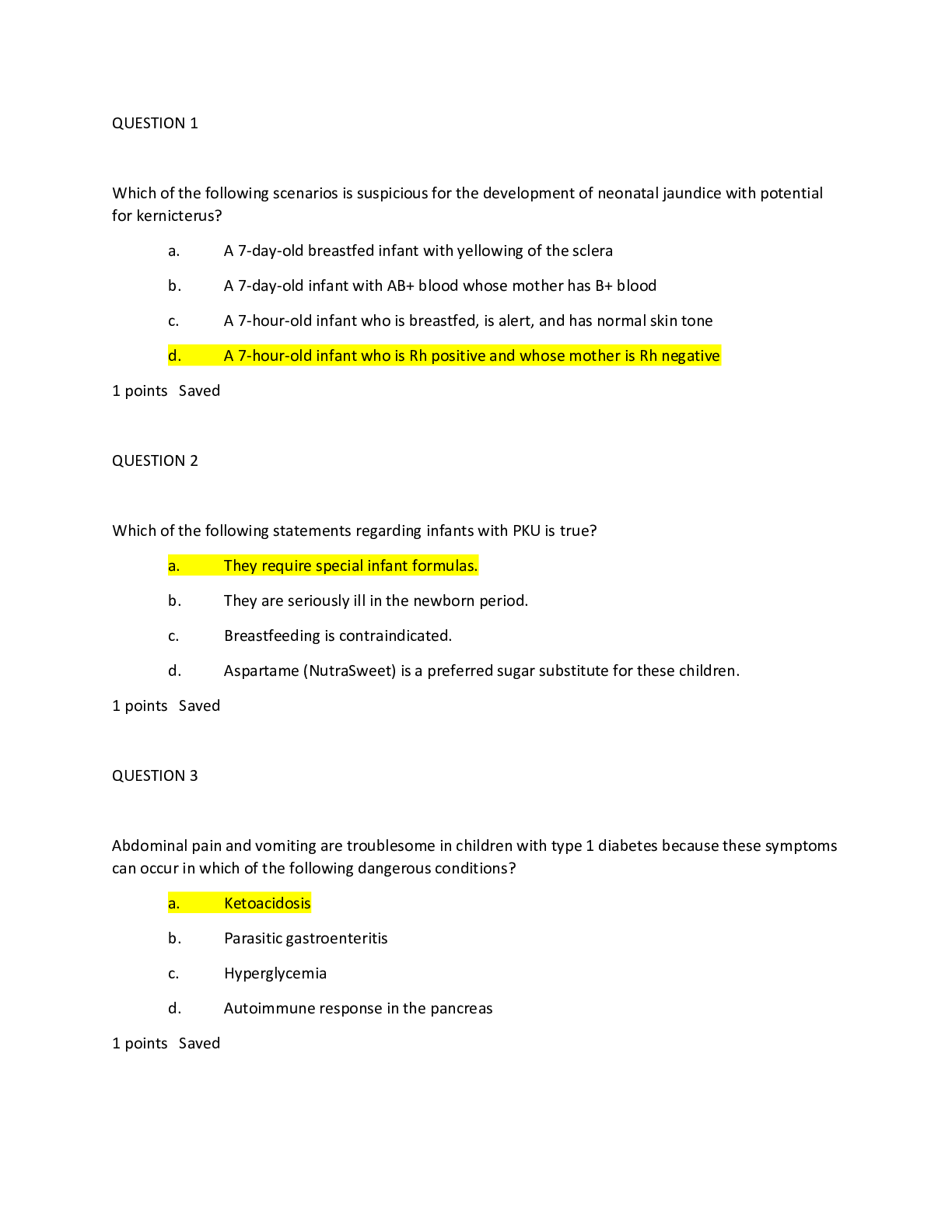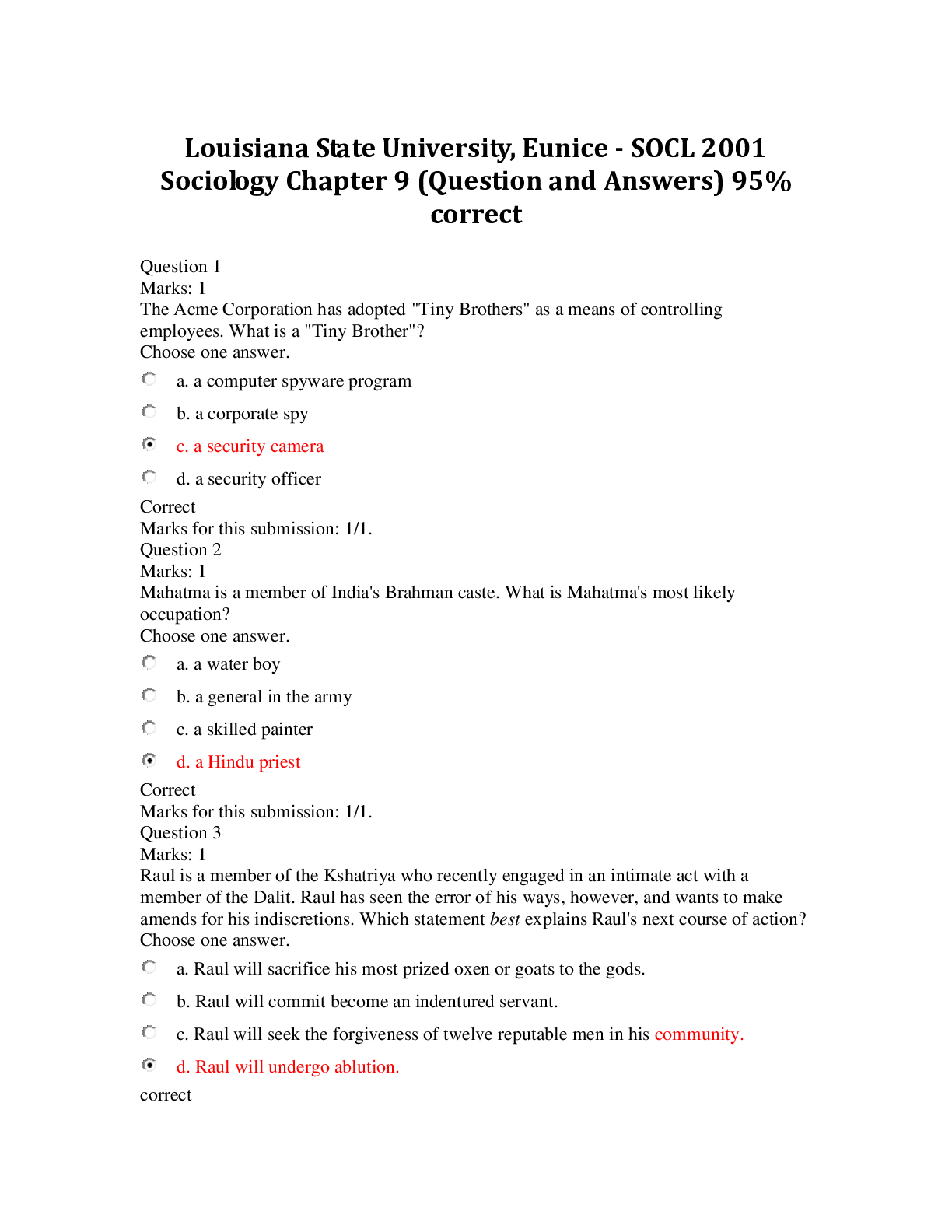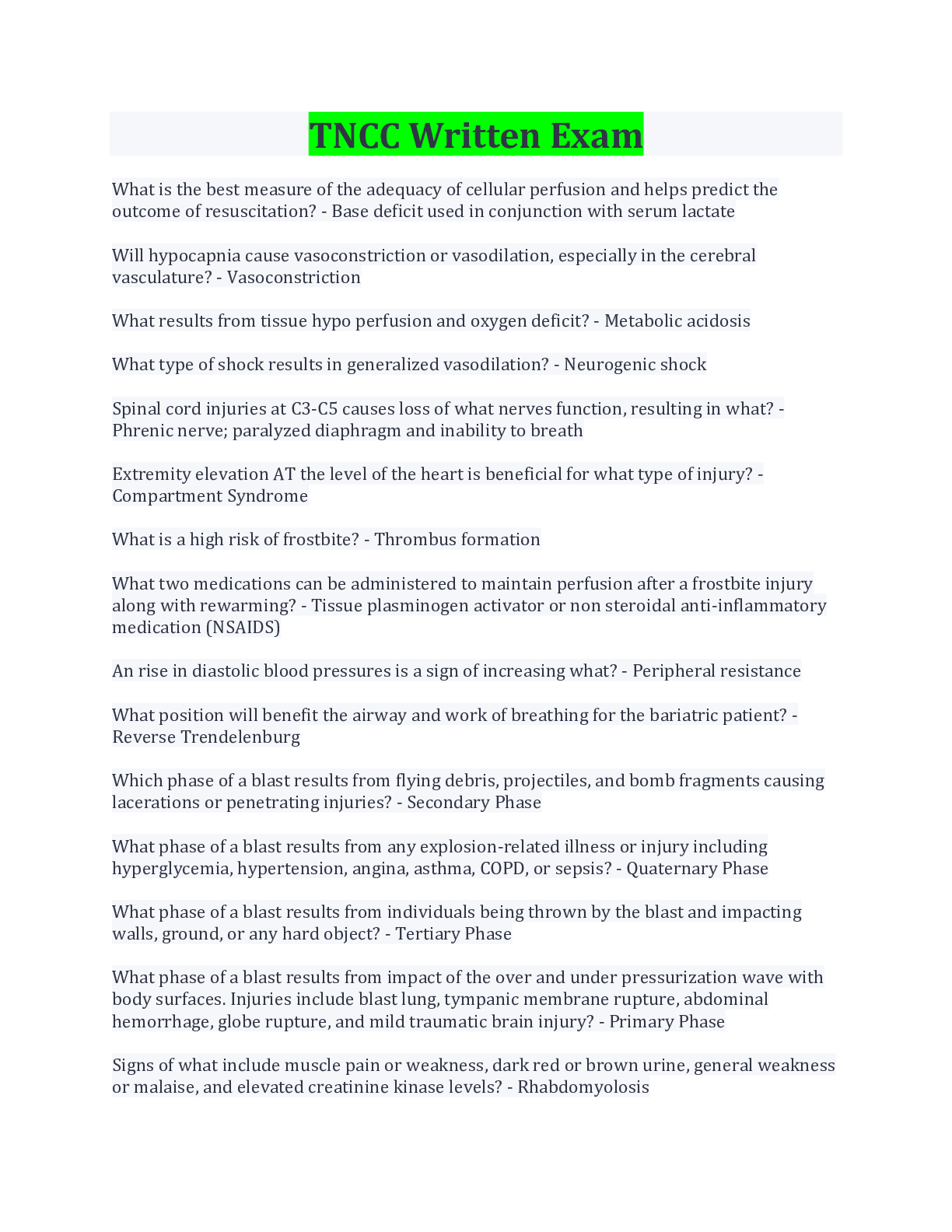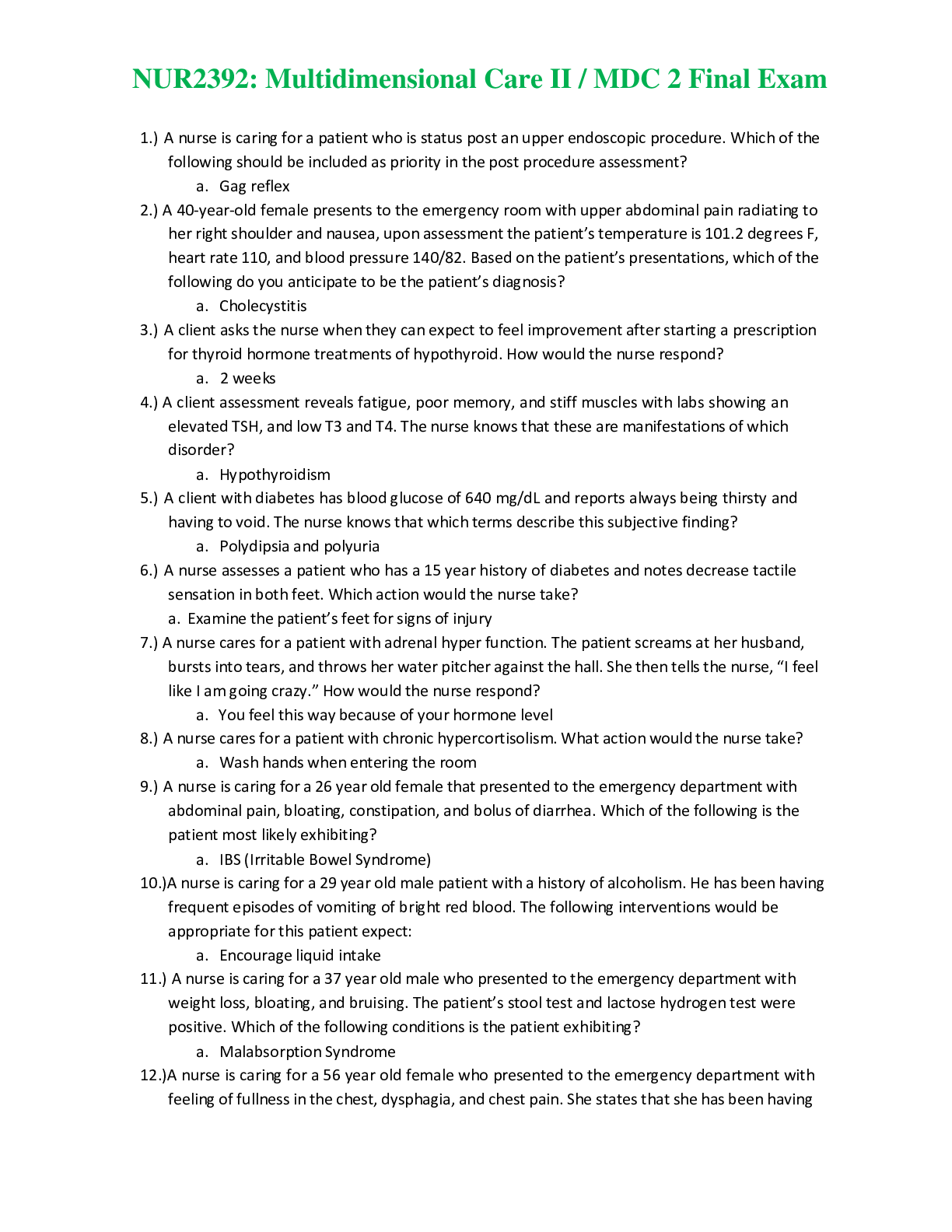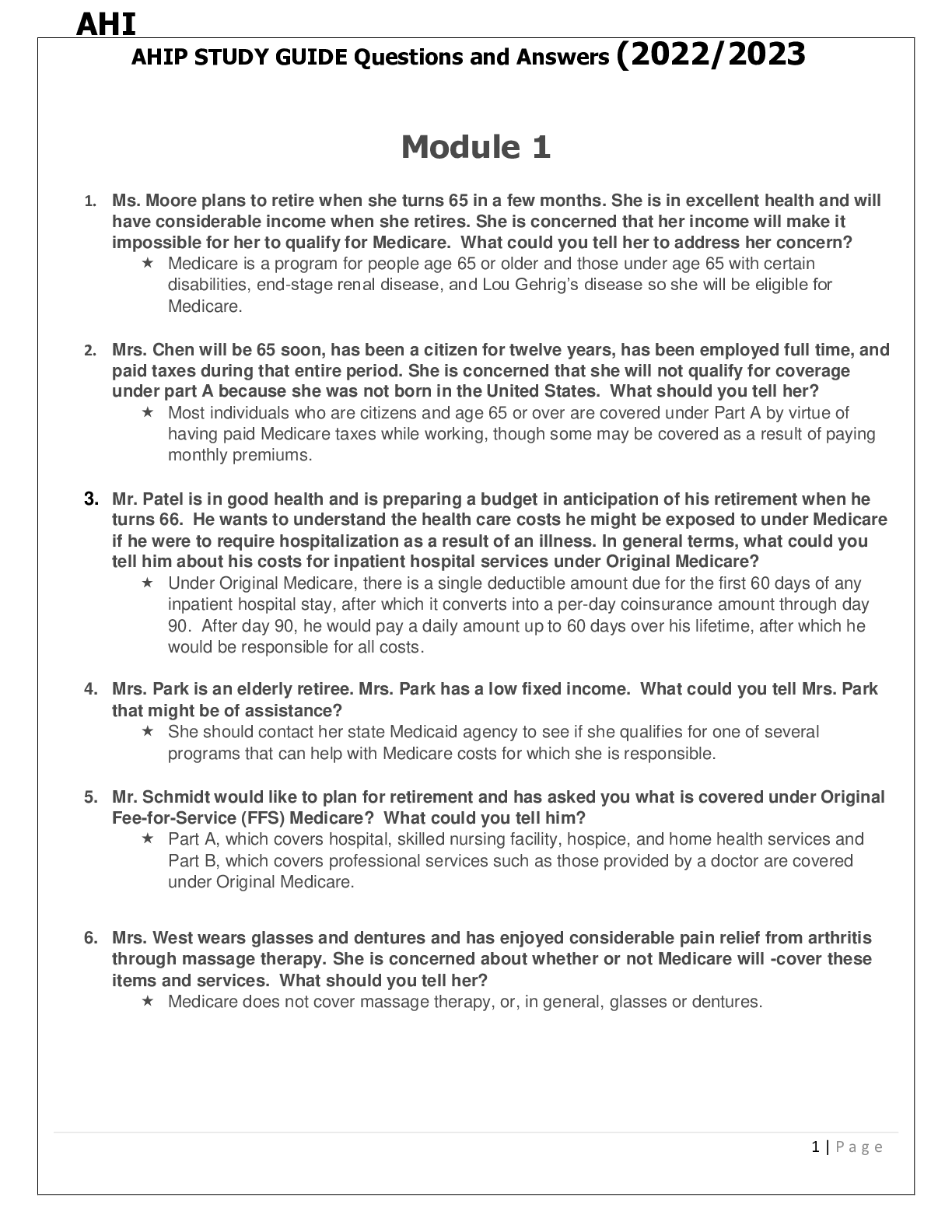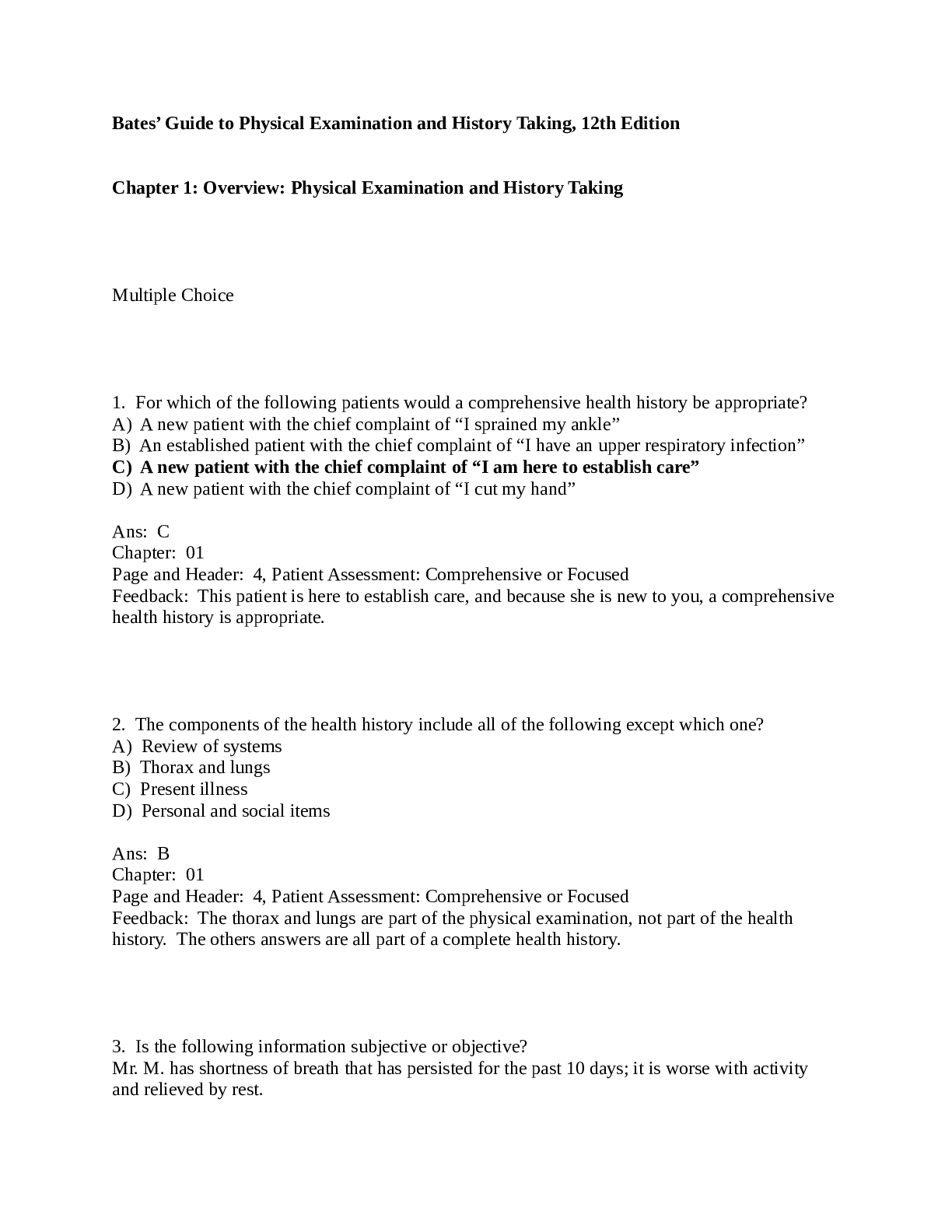*NURSING > QUESTIONS & ANSWERS > NR 503 Midterm Exam – Question and Answers NR 503 (All)
NR 503 Midterm Exam – Question and Answers NR 503
Document Content and Description Below
Chapters 2-4 1. Which of the following is a condition which may occur during the incubation period? a. Onset of clinical illness b. Receipt of infection c. Signs & symptoms of disease d. Transmi... ssion of infection e. Isolation of disease carrier through quarantine Rationale: The incubation period is defined as the interval from receipt of infection to the time of onset of clinical illness. Accordingly, individuals may transmit infectious agents during the incubation period as they show no signs of disease that would enable the isolation of sick individuals by quarantine. 2. Chicken pox is a highly communicable disease. It may be transmitted by direct contact with a person infected with the varicella-zoster virus (VZV). The typical incubation time is between 10 to 20 days. A boy started school 2 weeks after showing symptoms of chicken pox including mild fever, skin rash, & fluid-filled blisters. One month after the boy returned to school, none of his classmates had been infected by VZV. The main reason was: a. Herd immunity b. All had been immunized prior to the school year c. Contact was after infectious period d. Subclinical infections were not yet detected e. Disease was endemic in the class Rationale: The disease is spread by contact with an infected individual who can transmit the agent (VZV) to immunologically naive persons during the incubation period & for several days after onset of clinical illness. Since the boy started school 14 days after showing signs consistent with chicken pox, it is most likely that he was no longer infectious. 3. Which of the following is characteristic of a single-exposure, common-vehicle outbreak? a. Long latency period before many illnesses develop b. There is an exponential increase in secondary cases following initial exposures c. Cases include only those who have been exposed to sick persons d. The epidemic curve has a normal distribution when plotted against the logarithm of time e. Wide range in incubation times for sick individuals Rationale: Single-exposure, common-vehicle outbreaks involve a sudden, rapid increase in cases of disease that are limited to persons who share a common exposure. Additionally, few secondary cases develop among persons exposed to primary cases. A histogram of the outbreak can plot the number of cases by time of disease onset. In single-exposure, common-vehicle outbreaks, a log transformation of the time of disease onset will often take on the characteristic shape of a normal distribution (i.e., a bell curve) with the median incubation time found at the peak of the curve. 4. What is the diarrhea attack rate in persons who ate both ice cream & pizza? a. 39/52 b. 21/70 c. 39/67 d. 51/67 e. None of the above Rationale: The attack rate in this example is defined as the number of persons who develop diarrhea divided by the total number of people at risk. In this example, the at-risk group is those who have eaten both ice cream & pizza. Of these 52 persons, 39 developed diarrhea. 5. What is the overall attack rate in persons who did not eat ice cream? a. 30% b. 33% c. 35% d. 44% e. 58% Rationale: The attack rate is the number of persons with diarrhea (14 + 9) divided by the total number of persons who did not eat ice cream (40 + 30). 6. Which of the food items (or combination of items) is most likely to be the infective item(s)? a. Pizza only b. Ice cream only c. Neither pizza or ice cream d. Both pizza & icecream e. Cannot be assumed from the data shown Among persons eating ice cream, over 70% developed diarrhea regardless of their pizza consumption (39/52 & 11/15). Among both groups of persons who did not eat ice cream, each attack rate was equal to or less than 35% (14/40 & 9/30). 7. Which of the following reasons can explain why a person who did not consume the infective food item got sick? a. They were directly exposed to persons who did eat the infective food item b. Diarrhea is a general symptom consistent with a number of illnesses c. There may have been an inaccurate recall of which foods were eaten d. All of the above e. None of the above Rationale: Without knowledge as to the specific agent in this instance, it is also likely that it can be spread by direct contact with infected persons. Since diarrhea is a general disease symptom, it is possible that several infectious agents may be present at this meal or others eaten during the same time period. Further, information regarding food consumption may have been collected long after the disease episode. This may have led persons to incorrectly remember the foods that they consumed. An outbreak of gastroenteritis occurred at a boarding school with a student enrollment of 846. Fifty-seven students reported symptoms including vomiting, diarrhea, nausea, & low-grade fever between 10 p.m. on September 24 & 8 p.m. on September 25. The ill students lived in dormitories that housed 723 of the students. The table below provides information on the number of students per type of residence & the number reporting illnesses consistent with the described symptoms & onset time. Calculate the attack rate among all students at the boarding school. 1. Calculate the attack rate among all students at the boarding school. 57/846 = The answer is found by dividing the total number of cases (57) by the total number of students (846). This equals 6.7%. 10. Calculate the attack rates for boys & girls separately. a. For boys, the attack rate includes all cases (40 + 3) divided by the total number of students who are boys (380 + 46). The attack rate is 10.1%. b. For girls, the attack rate includes all cases (12 + 2) divided by the total number of students who are girls (343 + 77). The attack rate is 3.3%. 11. What is the proportion of total cases occurring in boys? Answer: The proportion of cases occurring in boys is equal to the number of cases in boys divided by the total number of cases (43/57). This equals 75.4%. 12. What is the proportion of total cases occurring in students who live in dormitories? Answer: The proportion of cases occurring in dormitory residents is equal to the number of cases in residents divided by the total number of cases (52/57). This equals 91.2%. 13. Which proportion is more informative for the purpose of the outbreak investigation? Answer: Both proportions are useful. Dormitory residents account for over 90% of the cases indicating an outbreak of an infectious agent that was transmitted at the school. Furthermore, over 75% of the cases were boys indicating that the responsible agent was more likely to have been transmitted in the boys’ dormitory. A group of researchers are interested in conducting a clinical trial to determine whether a new cholesterol-lowering agent was useful in preventing coronary heart disease (CHD). They identified 12,327 potential participants for the trial. At the initial clinical exam, 309 were discovered to have CHD. The remaining subjects entered the trial & were divided equally into the treatment & placebo groups. Of those in the treatment group, 505 developed CHD after 5 years of follow-up while 477 developed CHD during the same period in the placebo group. 14. What was the prevalence of CHD at the initial exam? Answer: The prevalence of CHD at the initial exam was 309 cases of CHD divided by 12,327 participants. This equals a prevalence of 25.1 cases of CHD per 1,000 persons. 15. What was the incidence of CHD during the 5-year study? Answer: The incidence rate reflects the number of new cases developing in the population at risk. Since prevalent CHD cases were excluded from the study, the population at risk was 12,018 (12,327 persons less 309 cases of CHD). During the 5-year study period, 982 incident cases of CHD developed. This equals an incidence rate of 81.7 cases of CHD per 1,000 persons. 16. Which of the following are examples of a population prevalence rate? a. The number of ear infections suffered by 3-year-old children in March, 2006 b. The number of persons with hypertension per 100,000 population c. The number of cases of skin cancer diagnosed in a dermatology clinic d. b & c e. All of the above Rationale: Prevalence is the number of affected persons in a specified population size at a given time. Only answer (b) fits this definition. Example (a) is more consistent with an incident rate while answer (c) is a selected group of persons who may not be representative of a general population. 17. What would be the effect on age-specific incidence rates of uterine cancer if women with hysterectomies were excluded from the denominator of incidence calculations assuming that most women who have had hysterectomies are older than 50 years of age. A. The rates in all age groups would remain the same. B. Only rates in women older than 50 years of age would tend to decrease. C. Rates in women younger than 50 years would increase compared to women older than 50 years of age. D. Rates would increase in women older than 50 years of age but may decrease in younger women as they get older. E. It cannot be determined whether the rates would increase or decrease. Rationale: Women who have had hysterectomies (i.e., removal of the uterus) are no longer at risk for uterine cancer. For women older than 50 years of age, this would increase the age-specific incidence rate as there would be the same number of uterine cancers occurring among fewer women at risk. Further, rates may decrease among younger women who have had hysterectomies as they are no longer at risk for uterine cancer & thus may decrease the number of potential cases occurring in their age group over time. A survey was conducted among 1,000 r&omly sampled adult males in the United States in 2005. The results from this survey are shown below. 18. The researchers stated that there was a doubling of risk of hypertension in each age group younger than 60 years of age. You conclude that the researchers’ interpretation: a. Is correct b. Is incorrect because prevalence rates are estimated c. Is incorrect because it was based on proportions of the population sample d. Is incorrect because incidence rates do not describe risk e. Is incorrect because the calculations do not include adult females Rationale: The survey reports the disease status of a population at a specific point in time. In this case, a r&om sample of adult males in 2005 provides a reliable estimate of the prevalence of hypertension. Since there is no information on duration of hypertension in these men, incidence cannot be calculated. Therefore, the researchers are not able to make a statement concerning risk of hypertension in the population. 19. The incidence & prevalence ra [Show More]
Last updated: 1 year ago
Preview 1 out of 21 pages

Reviews( 0 )
Document information
Connected school, study & course
About the document
Uploaded On
Apr 30, 2022
Number of pages
21
Written in
Additional information
This document has been written for:
Uploaded
Apr 30, 2022
Downloads
0
Views
64
.png)

.png)
.png)
.png)
.png)
.png)
.png)


